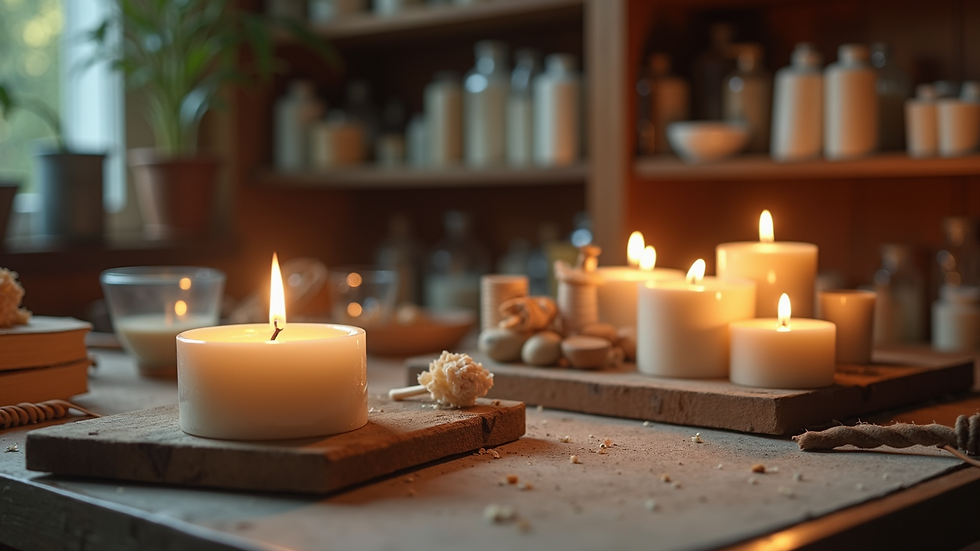Answers to Common Questions About Candle Making
- Flame Haven
- Sep 10
- 3 min read
Candle making is a rewarding and creative hobby that many people enjoy. Whether you want to make candles for your home, gifts, or even to start a small business, understanding the basics can help you get started with confidence. This article answers some of the most common questions about candle making, providing practical tips and insights to guide you through the process.
Candle Making FAQ: Essential Tips and Techniques
When starting candle making, many beginners wonder about the materials and methods involved. Here are some key points to consider:
Types of Wax: The most popular waxes are soy, paraffin, beeswax, and palm wax. Soy wax is eco-friendly and burns cleanly, making it a favorite for beginners. Paraffin wax is affordable and holds fragrance well but is petroleum-based. Beeswax has a natural honey scent and burns longer but is more expensive.
Choosing Wicks: The wick size and material affect how the candle burns. Cotton wicks are common, but wood wicks offer a unique crackling sound. Make sure the wick matches the candle diameter to avoid tunneling or excessive smoke.
Fragrance and Color: Use candle-specific fragrance oils and dyes. Essential oils can be used but may not always perform well in candles. Add fragrance at the right temperature (usually around 185°F) to ensure proper scent throw.
Melting and Pouring: Use a double boiler or a dedicated wax melter to melt wax safely. Pour the wax slowly and steadily into the container to avoid air bubbles.
Safety Tips: Always work in a well-ventilated area, keep a fire extinguisher nearby, and never leave melting wax unattended.

What Things Do I Wish I Knew Before Making Candles?
Many candle makers look back and wish they had known certain things before starting. Here are some insights that can save you time and frustration:
Patience is Key: Candle making requires patience, especially when waiting for wax to cool and set. Rushing can cause cracks or uneven surfaces.
Test Small Batches: Always test your fragrance and wick choices in small batches before making large quantities. This helps you avoid wasting materials.
Temperature Control Matters: Pouring wax at the wrong temperature can cause poor adhesion to containers or weak scent throw. Invest in a thermometer to monitor wax temperature accurately.
Label Your Experiments: Keep notes on your recipes, wick sizes, and pouring temperatures. This will help you replicate successful batches and improve over time.
Containers and Molds: Not all containers are suitable for candle making. Glass jars, tins, and silicone molds are popular choices. Make sure containers are heat-resistant.

How to Troubleshoot Common Candle Making Problems
Even experienced candle makers face challenges. Here are solutions to some frequent issues:
Tunneling: When the candle burns down the center, leaving wax on the sides. Use a larger wick or ensure the wick is centered. Also, allow the candle to burn long enough for the wax to melt evenly across the surface.
Frosting: A white, crystalline appearance on soy candles. This is natural and does not affect performance. To reduce frosting, try using additives or blending waxes.
Soot and Smoke: Caused by too large a wick or poor air circulation. Trim the wick to 1/4 inch before each burn and avoid drafts.
Cracks and Shrinkage: Pour wax at the recommended temperature and avoid rapid cooling. Insulating containers can help maintain even cooling.
Weak Scent Throw: Increase fragrance load within safe limits or try different fragrance oils. Also, ensure the candle is cured properly before burning.

How to Choose the Right Supplies for Your Candle Making Project
Selecting the right supplies can make a big difference in your candle making experience. Here’s what to look for:
Wax Type: Choose based on your preference for natural ingredients, scent throw, and budget.
Wicks: Match the wick size to your container diameter. Cotton wicks are versatile, but wooden wicks add ambiance.
Containers: Glass jars are popular for container candles. For pillar candles, use silicone molds or metal molds.
Fragrance Oils: Use oils specifically designed for candles to ensure safety and scent quality.
Tools: Invest in a thermometer, pouring pitcher, double boiler, and wick holders to keep wicks centered.
Safety Gear: Gloves, safety glasses, and a fire extinguisher are essential for safe candle making.
Where Can I Find More Answers to Candle-Making Questions?
If you want to dive deeper into candle making or have specific questions, many resources are available online. One excellent place to explore is the candle-making questions page, which covers a wide range of topics from beginner tips to advanced techniques.
Exploring FAQs and community forums can also provide valuable insights and inspiration. Remember, candle making is a craft that improves with practice and experimentation.
By understanding these common questions and tips, you can create beautiful, fragrant candles that burn well and look professional. Happy candle making!










Comments